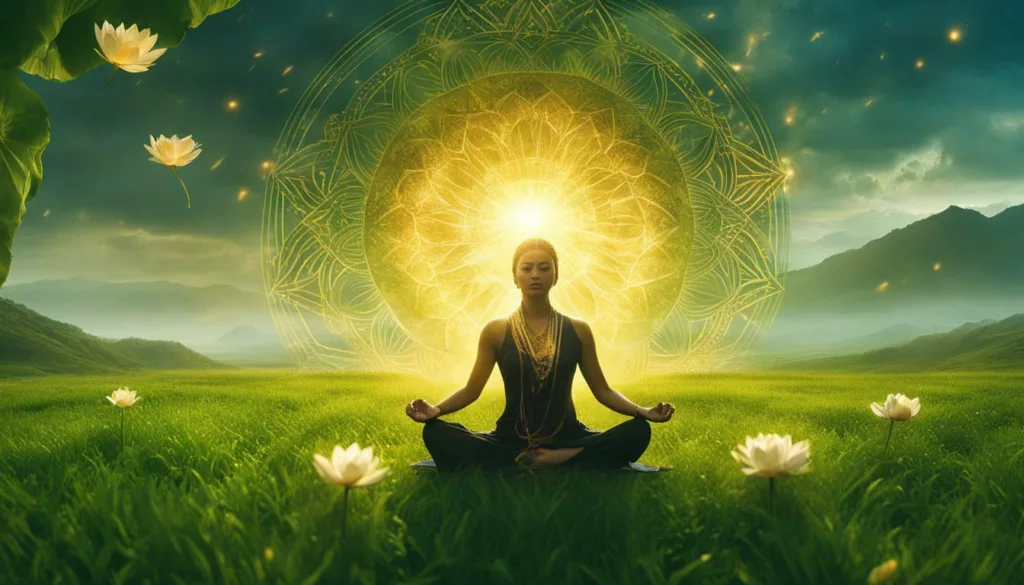Levitation has long been a subject of fascination and wonder. Many wonder if it is possible to harness this extraordinary ability while in a deep meditative state. In this article, we will delve into the intriguing question of whether it is possible to levitate while meditating. We’ll explore the concept of levitation meditation and discuss its potential for achieving levitation through focused practice.
- Levitation through meditation is a topic of interest and curiosity.
- Accounts from yogis and meditation masters suggest that levitation is achievable through advanced practices.
- Mastery of meditation techniques, such as pranayama and energy control, are believed to facilitate the ability to levitate.
- Understanding and controlling pranas and vayus within the body play a role in levitation meditation.
- The practice of bandhas and consistent dedication are essential elements in exploring levitation through meditation.
Unlocking the Mysteries of Levitation through Meditation
Meditation has been credited with the ability to unlock hidden powers within the human body and mind. Could it also hold the key to levitation? It is a question that has fascinated many seekers on the path of spiritual growth. While the concept of levitating might seem far-fetched to some, there are accounts from ancient yogic traditions and revered spiritual masters that suggest otherwise.
In ancient texts, the power of levitation, known as “dardura siddhi” in Sanskrit, is described as the ability to float in mid-air. According to these sources, certain yogis and meditation masters have achieved this extraordinary feat through their dedicated practice. They claim that through specific meditation techniques, combined with breath control and the understanding of energy currents within the body, levitation becomes a possibility.
One of the key practices associated with levitation meditation is pranayama, the art of breath control. By mastering different pranayama techniques, practitioners aim to expand their energy and enhance their ability to harness prana, the life force energy. It is believed that through pranayama, one can influence the Udana Vayu, the vital energy responsible for upward movement in the body, and thus, open the doorway to levitation.

Additionally, the practice of bandhas, energy locks within the body, plays a crucial role in levitation meditation. By mastering these bandhas and channeling the energy flow, practitioners aim to raise their vibration and create the conditions necessary for levitation to occur. Alongside these specific techniques, a strong will and consistent practice are emphasized as essential components in the pursuit of levitation through meditation.
| Benefits of Levitation Meditation: |
|---|
| Enhanced focus and concentration |
| Deeper states of relaxation and stillness |
| Increased body-mind awareness |
| Heightened spiritual experiences |
While it is important to approach the topic of levitation with an open mind, it is equally essential to understand that levitating is not a guaranteed outcome of meditation practice. However, the techniques and practices associated with levitation meditation offer a fascinating exploration of the untapped potential within each individual. Whether or not levitation occurs, the journey itself can lead to profound personal growth and transformation.
The Ancient Wisdom of Levitation: Insights from Yogic Traditions
Ancient yogic texts and traditions have long hinted at the possibility of levitation through meditation. Let’s explore the insights and benefits they offer.
Swami Rama, in his book “Living with the Himalayan Masters,” describes witnessing yogis levitating effortlessly during their meditation practice. He explains that these advanced practitioners have honed their ability to harness and direct the subtle energies within their bodies, allowing them to defy gravity.
Levitation meditation, known as “dardura siddhi” in Sanskrit, holds significance in yogic philosophy. It is believed that through mastery of specific meditation techniques and breath control, one can unlock the potential for levitation. By understanding and manipulating the pranas or vayus, the vital energy currents within the body, yogis aim to channel the upward energy flow governed by the Udana Vayu.
| Benefits of Levitation Meditation |
|---|
| Enhanced focus and concentration |
| Deepened states of relaxation |
| Heightened spiritual awareness |
| Strengthened mind-body connection |
- Mastery of Energy Locks: Bandhas and Levitation
Bandhas, the energy locks practiced in yoga, play a vital role in levitation meditation. By engaging and releasing these muscle contractions in specific areas of the body, yogis enhance the flow of energy and cultivate a strong willpower. With consistent practice, mastery of bandhas contributes to the possibility of experiencing levitation during meditation.

Exploring the potential for levitation through meditation requires dedication and consistent practice. By incorporating levitation techniques into regular meditation routines, individuals can gradually unlock their latent abilities. It is essential to approach the practice with an open mind and an understanding that the outcome is not guaranteed. However, the journey itself is rich with personal growth and self-discovery.
As we continue our exploration of levitation through meditation, let us remember the wisdom passed down through yogic traditions. While levitation may seem like an extraordinary feat, it serves as a reminder of the limitless potential of the human mind and spirit.
The Power of Pranayama: Breath Control for Levitation
Pranayama, the expansion and control of energy through breathwork, forms a crucial element in the exploration of levitation through meditation. By harnessing the power of the breath, practitioners aim to enhance their meditation practice and potentially unlock the ability to levitate.
In the pursuit of levitation, specific pranayama techniques are utilized to manipulate the flow of prana, the life force energy, within the body. One such technique is the Kapalabhati, also known as the Skull Shining Breath. This dynamic breathing exercise involves forceful exhalations followed by passive inhalations, creating a cleansing effect on the mind and body. Kapalabhati is believed to awaken and energize the Udana Vayu, the energy responsible for upward movement in the body. By harmonizing the breath with focused intention, practitioners hope to facilitate the experience of levitation.
Another pranayama technique commonly associated with levitation meditation is Nadi Shodhana, or Alternate Nostril Breathing. This practice involves alternating between breathing through the left and right nostrils, balancing the flow of energy throughout the body. By purifying the nadis, the energy channels, practitioners aim to create equilibrium and harmony, which may contribute to the possibility of levitation.
| Pranayama Techniques for Levitation Meditation |
|---|
| Kapalabhati (Skull Shining Breath) |
| Nadi Shodhana (Alternate Nostril Breathing) |
While there may not be scientific evidence to support the claim of levitation through meditation, the centuries-old wisdom passed down through yogic traditions offers insights into the potential connection between breath control and extraordinary abilities. It is important to approach the exploration of levitation with an open mind and a willingness to delve into the depths of meditation and pranayama practices.

“Pranayama is a portal to the infinite possibilities that lie within us. Through conscious breath control, we can access and channel the subtle energies that can enable extraordinary experiences in meditation.” – Yogi Master
Understanding the Energy Within: Prana and Vayus
To unlock the potential of levitation, one must navigate the intricate web of prana and vayus within the body. Prana, often referred to as the life force energy, flows through various channels known as vayus. These vayus govern different aspects of our being, with the Udana Vayu being crucial for exploring levitation during meditation.
“The upward wind carries the soul to the higher realms of consciousness,” explained Swami Rama in his book “Living with the Himalayan Masters.” He described how yogis who have mastered the Udana Vayu can effortlessly defy gravity and float above the ground, embodying the ancient wisdom of levitation. This phenomenon is not bound by the laws of physics but rather by the mastery of the subtle energies within.
Practitioners of levitation meditation focus on awakening and directing the Udana Vayu through specific techniques. By harmonizing breath and intention, they aim to harness the upward flow of energy, lifting themselves beyond the constraints of the physical realm. It requires a deep understanding of prana and the ability to manipulate its currents, which can be achieved through consistent practice and disciplined meditation routines.

This image showcases the profound connection between meditation and levitation, capturing the essence of how energy can be harnessed and elevated through focused practice. As one delves deeper into the exploration of levitation, it becomes evident that the ancient yogic traditions hold invaluable insights into the potential of human consciousness.
Unlocking the Power Within: Exploring Levitation Through Meditation
“The power of levitation lies in our ability to tap into the infinite potential within ourselves,”
said Yogananda in his renowned book “Autobiography of a Yogi.” These profound words remind us of the limitless possibilities that can be attained through dedicated meditation and the mastery of our inner energies.
| Benefits of Exploring Levitation During Meditation | Techniques for Achieving Levitation |
|---|---|
|
|
While the power of levitation remains an awe-inspiring mystery, it is through the exploration of prana, vayus, and the intricate web of energy within us that we may come closer to understanding this extraordinary phenomenon. By delving into ancient wisdom, mastering breath control, and embracing consistent practice, we can embark on a transformative journey towards unlocking the hidden potentials within our own beings.
Energy Locks and Willpower: Bandhas and Levitation
Energy locks known as bandhas are said to hold the key to unlocking the potential for levitation while meditating. These internal locks are subtle yet powerful techniques that involve the contraction and release of specific muscles in the body, directing and controlling the flow of energy. By mastering these bandhas, combined with a strong willpower, practitioners aim to enhance their ability to experience levitation during meditation.
The primary bandhas associated with levitation meditation are Mula Bandha, Uddiyana Bandha, and Jalandhara Bandha. Mula Bandha, also known as the Root Lock, involves engaging the muscles of the pelvic floor, creating stability and upward energy flow. Uddiyana Bandha, the abdominal lock, requires drawing the abdomen in and up towards the spine, creating a hollow space in the lower belly. Jalandhara Bandha, or the Throat Lock, involves gently pressing the chin towards the sternum, activating the throat and neck muscles.
These bandhas, when synchronized with the breath and combined with a focused mind, create a powerful synergy. By redirecting and channeling the prana, or life force energy, through these specific energy locks, practitioners aim to elevate their consciousness and ultimately transcend the limitations of gravity. While levitation may not happen instantly or for everyone, consistent practice and patient exploration of these bandhas can gradually unlock the potential for this extraordinary experience.
| Bandhas | Location | Description |
|---|---|---|
| Mula Bandha | Pelvic floor | Engaging the muscles of the pelvic floor, creating stability and upward energy flow |
| Uddiyana Bandha | Abdomen | Drawing the abdomen in and up towards the spine, creating a hollow space in the lower belly |
| Jalandhara Bandha | Throat and neck | Gently pressing the chin towards the sternum, activating the throat and neck muscles |
Exploring the potential of levitation through bandhas requires patience, dedication, and a deep understanding of the body’s energetic system. The combination of mastering these energy locks with a strong willpower is believed to create the optimal conditions for the manifestation of levitation during meditation. While the phenomenon of levitation remains shrouded in mystery and may elude many practitioners, the journey of exploring these bandhas and cultivating inner balance and control can be a rewarding experience in itself.

The mastery of bandhas is just one aspect of the intricate tapestry of levitation meditation. Beyond bandhas, the practice involves a holistic approach to meditation and energy work. It encompasses techniques such as pranayama, the art of breath control, and the exploration of prana and vayus, the vital energy currents within the body.
By incorporating these various aspects into their practice, meditators aim to harmonize their physical body, mind, and energy field, creating the ideal conditions for the manifestation of levitation. The journey of unlocking levitation potential through meditation is a profound exploration of the inner self and a testament to the limitless possibilities that lie within.
Exploring the Possibilities: Practice and Consistency
Levitation is not an overnight achievement but rather a result of persistent practice and an unwavering dedication to the meditation journey. By incorporating levitation techniques into our regular meditation routines, we gradually pave the way for the exploration of this extraordinary phenomenon. It is through consistent practice that we begin to unlock the potential within ourselves.
Just as with any skill, achieving levitation through meditation requires patience and perseverance. It is important to approach the practice with an open mind and a willingness to explore our inner energies. By delving into the ancient wisdom of yogic traditions and integrating pranayama, the practice of breath control, we can deepen our meditation practice and potentially facilitate the ability to levitate.
One powerful aspect of levitation meditation is the understanding and control of the life force energy within us, known as prana. By exploring the different vayus, or vital energy currents, particularly the Udana Vayu responsible for upward energy flow, we can tap into the potential for levitation. Through dedicated practice and focused attention, we can harness and direct these energies to enhance our meditation experience.

Additionally, the mastery of energy locks referred to as bandhas, along with a strong will, plays a significant role in levitation meditation. These energy locks help channel and control the flow of energy within our bodies, creating a harmonious balance and opening up new possibilities. With consistent practice and the development of these skills, we can lay the foundation for the potential experience of levitation.
While levitation itself may not be guaranteed, the journey of exploration is a profound one. Through regular practice, we cultivate a deeper connection with ourselves and tap into the limitless potential of the human mind and spirit. So let us embark on this remarkable journey, dedicated to unlocking the mysteries of levitation through meditation.
Conclusion
Levitation remains a fascinating and mysterious phenomenon, and while it may not be achievable for everyone, the exploration of levitation through meditation offers a profound journey of self-discovery and growth. Throughout this article, we have delved into the intriguing question of whether it is possible to levitate while meditating. We have explored the concept of levitation meditation and discussed its potential for achieving levitation through focused practice.
Drawing from ancient yogic traditions, we have uncovered the wisdom behind levitation meditation and shed light on the benefits of incorporating levitation practices into meditation routines. The practice of pranayama, breath control, has emerged as a powerful tool in enhancing meditation and potentially facilitating the ability to levitate. By understanding and controlling the energy currents within our body, particularly the upward flow of energy known as Udana Vayu, we can tap into the potential for levitation.
Moreover, we have discovered the importance of energy locks called bandhas and the role they play in the practice of levitation meditation. Mastery of these bandhas, coupled with a strong willpower and consistent practice, can greatly enhance the chances of experiencing levitation during meditation.
While levitation is not a guaranteed outcome, the techniques and practices explored in this article invite us to embark on a journey of self-exploration and growth. By incorporating these practices into our meditation routines and dedicating ourselves to consistent practice, we can unlock new potentials within ourselves, even if full levitation remains elusive. Let us embrace the mysteries of levitation and revel in the transformative power of meditation.
FAQ
Q: Is levitation while meditating a real phenomenon?
A: According to various sources, including Swami Rama’s “Living with the Himalayan Masters” and Yogananda’s Autobiography of a Yogi, there are accounts of yogis and meditation masters who claim to have the ability to levitate through advanced yoga practices and meditation.
Q: What is the power of levitation called in Sanskrit?
A: The power of levitation is referred to as “dardura siddhi” in Sanskrit, which translates to the frog power.
Q: How can meditation and pranayama lead to levitation?
A: Mastery of meditation and pranayama, the expansion of energy through breath control, is believed to facilitate levitation. By understanding and controlling the various pranas or vayus within the body, particularly the Udana Vayu governing upward energy flow, levitation may become possible.
Q: What role do energy locks known as bandhas play in levitation?
A: Energy locks, or bandhas, are important in the practice of levitation meditation. Mastering these bandhas, along with a strong willpower, can enhance the chances of experiencing levitation during meditation.
Q: Is levitation guaranteed through meditation?
A: While there is no guarantee of levitation, the techniques and practices discussed in meditation can be actively explored and practiced.

